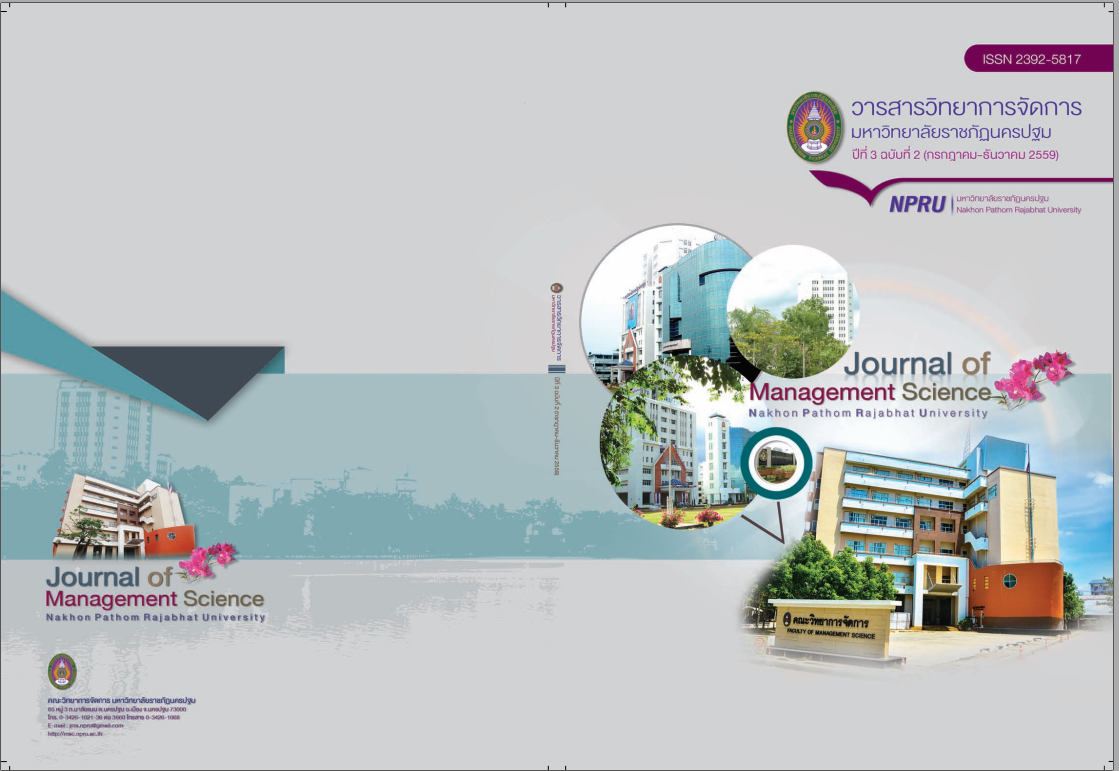Guidelines for Promoting Organizational Commitment of Personnel in Textile Industry in Sam Phran District, Nakhon Pathom Province.
Main Article Content
Abstract
The objectives of the research were to: 1) study 8 happiness indexes and organizational commitment of personnel in textile industry; 2) compare organizational commitment of personnel as classified by personal factors; 3) study 8 happiness indexes affecting organizational commitment of personnel; and identify guidelines for promoting organizational commitment of personnel. The sample was 278 personnel in textile industry in Sam Phran District, Nakhon Pathom Province, derived by simple random sampling from drawing lots, and 3 interviewees derived by purposive sampling. The research instruments were a questionnaire and an interview form constructed by the researcher. Descriptive statistics used for data analysis were percentage, mean and standard deviation, and inferential statistics used were t-test, one-way analysis of variance, least significant difference, correlation coefficient, stepwise multiple regression and content analysis.
The findings of this research were as follows:
1. Overall the 8 happiness indexes of personnel in textile industry was at a high level, while the organizational commitment was at a high level.
2. The personnel with differences in work tenure and income had different level of organizational commitment with a statistical significance level of .05. However, there was no difference with those classified by gender and position.
3. The 8 happiness indexes had positive relation with organizational commitment with a statistical significance level of .01. Moreover, the happiness indexes in the aspects of happy society, happy brain, happy money and happy heart affected personnel’s organizational commitment at the percentage of 43.
4. Guidelines for promoting organizational commitment were reducing conflicts; building labor relations; placing importance in giving equal benefits to all employees; providing knowledge through monthly training; listening to personnel’s opinions; reminding personnel about relaxation, exercise and healthcare; and constructing good environment in workplace.
Article history : Accepted 7 September 2014
SIMILARITY INDEX = 0.00
Article Details
The views and opinions of the article appearing in this journal are those of the author. It is not considered a view and responsibility of the editorial staff.
References
จงจิต เลิศวิบูลย์มงคล และ ยุพิน อังสุโรจน์. (2547). ปัจจัยส่วนบุคคล การได้รับการเสริมสร้างพลังอำนาจในงาน แรงจูงใจใฝ่สัมฤทธิ์ กับความสุขในการทำงานของพยาบาลประจำการ โรงพยาบาลมหาวิทยาลัยของรัฐ. วารสารสภาการพยาบาล. 19 (2) ,25-38.
ชวนพิศ นาเลี้ยง. (2558). ปัจจัยที่มีผลต่อความสุขจากการปฏิบัติงานของพนักงานสายสนับสนุน มหาวิทยาลัยศิลปากร. วิทยานิพนธ์ปริญญาบริหารธุรกิจมหาบัณฑิต. สาขาวิชาการจัดการทั่วไป มหาวิทยาลัยราชภัฏนครปฐม.
ชัยวัฒน์ ธนาคมชากร. (2549) .ปัจจัยที่มีผลต่อความผูกพันต่อองค์กรของพนักงานกลุ่มธุรกิจสารสนเทศและการสื่อสาร : กรณีศึกษาบริษัท ซีเมนต์ จำกัด. บริหารธุรกิจมหาบัณฑิต. มหาวิทยาลัยเกษตรศาสตร์.
ชาญวิทย์ วสันต์ธนารัตน์. (2552). มาสร้างองค์กรแห่งความสุขกันเถอะ. กรุงเทพฯ : สำนักงานกองทุนสนับสนุนการสร้างเสริมสุขภาพ (สสส.).
นูรีนัน ดอเลาะ อนิวัช แก้วจำนงค์ และอรจันทร์ ศิริโชติ. (2556). ความผูกพันต่อองค์การของบุคลากร มหาวิทยาลัยนราธิวาสราชนครินทร์. วารสาร มหาวิทยาลัยนราธิวาสราชนครินทร์. 5(3),110-121.
นภัส จิตต์ธีรภาพ. (2554). ปัจจัยส่วนบุคคล ความสุขในการทำงาน และความผูกพันต่อองค์การของพนักงาน : กรณีศึกษาโรงงานอุตสาหกรรมอาหารแห่งหนึ่ง.วิทยานิพนธ์ปริญญาศิลปศาสตรมหาบัณฑิต สาขาวิชาจิตวิทยาอุตสาหกรรมและองค์การ ภาควิชาจิตวิทยาศิลปศาสตร์. มหาวิทยาลัยธรรมศาสตร์.
ปาริชาติ ปานสำเนียง. (2555). การศึกษาคุณภาพชีวิตในการทำงานและการรับรู้ความยุติธรรมในองค์กรที่มีอิทธิพลต่อพฤติกรรมการเป็นสมาชิกที่ดีต่อองค์กรผ่านความผูกพันต่อองค์กรของพนักงาน มหาวิทยาลัยสายสนับสนุนกรณีศึกษาคณะแพทย์แห่งหนึ่งในกรุงเทพมหานคร. บัณฑิตวิทยาลัย. สาขาวิชาการจัดการภาครัฐและภาคเอกชน. มหาวิทยาลัยศิลปากร.
พรรณี อังศุสิงห์. (2548). ความผูกพันต่อองค์กรของพนักงานสถาบันรับรองมาตรฐานไอเอสโอ. บริหารธุรกิจมหาบัณฑิต. มหาวิทยาลัยเกษตรศาสตร์.
รวมศิริ เมนะโพธิ. (2550). เครื่องมือ การวัดการทำงานอย่างมีความสุข: กรณีศึกษา นักศึกษาภาคพิเศษระดับปริญญาโทสถาบันบัณฑิตพัฒนบริหารศาสตร์. สารนิพนธ์ปริญญามหาบัณฑิต. สถาบันบัณฑิตพัฒนบริหารศาสตร์.
วรพล โสคติยานุรักษ์. (2549). ดัชนีเศรษฐกิจ ความอยู่ดี กินดี มีสุขของครัวเรือน. คณะรัฐประศาสนศาสตร์. สถาบันบัณฑิตพัฒนบริหารศาสตร์.
วรรณิภา นิลวรรณ (2554) ความผูกพันต่อองค์การของข้าราชการครูและบุคลากรทางการศึกษาในวิทยาเขตอาชีวศึกษาสุราษฎร์ธานี จังหวัดสุราษฎร์ธานี. บริหารธุรกิจมหาบัณฑิต วิชาเอกการจัดการทั่วไป. คณะบริหารธุรกิจ. มหาวิทยาลัยเทคโนโลยีราชมงคลธัญบุรี.
ศูนย์สารสนเทศโรงงานอุตสาหกรรมกรมโรงงานอุตสาหกรรม. รายงานความเคลื่อนไวการลงทุนอุตสาหกรรมของจังหวัดนครปฐม ประจำเดือนกุมภาพันธ์ 2558. [ออนไลน์] ค้นเมื่อ 25 พฤศจิกายน 2558, จาก https://www.industry.go.th/nakhonpathom/index.php/docman/5--2558-1
สิรินทร แซ่ฉั่ว (2553) .ความสุขในการทำงานของบุคลากรเชิงสร้างสรรค์ : กรณีศึกษาอุตสาหกรรมเชิงสร้างสรรค์กลุ่มสื่อและกลุ่มงานสร้างสรรค์เพื่อการใช้งาน. วิทยานิพนธ์วิทยาศาสตรมหาบัณฑิต (การพัฒนาทรัพยากรมนุษย์และองค์การ).คณะพัฒนาทรัพยากรมนุษย์.สถาบันบัณฑิตพัฒนบริหารศาสตร์.
อภิพงศ์ โชติรัตน์. (2557). ความผูกพันต่อองค์การ ศึกษากรณีเฉพาะ พนักงานสายงานท่าอากาศยานกรุงเทพ บริษัทท่าอากาศยานไทยจำกัด (มหาชน). การค้นคว้าอิสระ บริหารธุรกิจมหาบัณฑิต. บัณฑิตวิทยาลัยมหาวิทยาลัยกรุงเทพ.
Allen, N. J. & J. P. Meyer. (1990). The measurement and antecedents of affective continuance and normative commitment to the organization. The journal of occupational Psychology. 63(1) ,1-18. DOI: 10.1111/j.2044-8325.1990.tb00506.x.
Best.J.W. and Kahn J.V.(1998). Research in Education. (3rd ed.). New Jersey : Printice-Hall.
Buchanan, B. (1974). Building Organizational Commitment: The Socialization of Manager in Work Organization. Administrative Science Quarterly. (19), 533-546.
Hrebiniak, L. G. , & Alutto, J. A. (1972). Personal and role-related factors in the development of organizational commitment. Administrative Science Quarterly, 17, 555-573.
Krejcie, R. V. & Morgan, D. W. (1970).Determining Sample Size for Research Activities. Educational and psychological measurement,30(3), 607-610.


